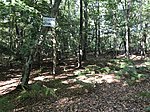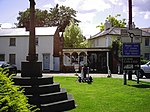Chobham Common
National nature reserves in EnglandNature Conservation Review sitesSpecial Areas of Conservation in EnglandSpecial Protection Areas in EnglandSurrey Wildlife Trust ... and 1 more
Use British English from February 2021

Chobham Common is a 655.7-hectare (1,620-acre) biological Site of Special Scientific Interest north of Chobham in Surrey. It is a Nature Conservation Review site, Grade I and a national nature reserve. It is part of the Thames Basin Heaths Special Protection Area and the Thursley, Ash, Pirbright and Chobham Special Area of Conservation. It contains three scheduled monuments. Most of the site is managed by the Surrey Wildlife Trust as the Chobham Common nature reserve, but the SSSI also includes a small private reserve managed by the Trust, Gracious Pond.
Excerpt from the Wikipedia article Chobham Common (License: CC BY-SA 3.0, Authors, Images).Chobham Common
Staple Hill, Surrey Heath
Geographical coordinates (GPS) Address Nearby Places Show on map
Geographical coordinates (GPS)
| Latitude | Longitude |
|---|---|
| N 51.373 ° | E -0.604 ° |
Address
Staple Hill
Staple Hill
GU24 8TU Surrey Heath
England, United Kingdom
Open on Google Maps




